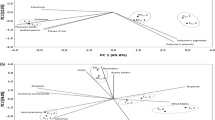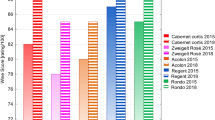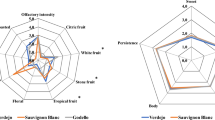Abstract
The oxidation of two premium wines, Chianti Classico and Brunello di Montalcino, obtained from Sangiovese grapes in 2017 and 2018 vintages, is simulated through oxygen exposure by applying three consecutive saturation/consumption cycles. After each oxidation cycle, wines are analyzed for color intensity, hue, CIElab coordinates, polymeric pigments, monomeric anthocyanins, acetaldehyde, tannins, and flavans and compared to control wines. By increasing the oxygen supply, monomeric anthocyanins decrease faster in the younger wines, acetaldehyde is highly produced in the older ones, while the formation of polymeric pigments depends on the wine type. The color intensity, the yellow and blue tint increase in all wines. The effect of oxidation on main phenolic compounds is more affected by the wine age than the type. Oxidation also significantly affects wine sensory characteristics: the astringency intensity decreases, whereas the subqualities of silk and velvet increase. The percentage increase of the silky sensation is from four to sevenfold higher in young wines. The silkiness is correlated with some anthocyanins decrease [malvidin 3-(6II-acetyl)-monoglucoside, delphinidin 3-monoglucoside, petunidin 3-monoglucoside, malvidin 3-monoglucoside]; the velvet sensation with polymeric pigments formation, acetaldehyde production, and malvidin 3-(6II-acetyl)-monoglucoside decrease. Moreover, after oxidation, aged wines are characterized by an enhanced balsamic odor and aroma.





Similar content being viewed by others
Data availability
Data are available upon request; instead, wines are not more available.
References
Arapitsas P, Perenzoni D, Nicolini G, Mattivi F (2012) Study of Sangiovese wines pigment profile by UHPLC-MS/MS. J Agric Food Chem. https://doi.org/10.1021/jf302617e
Nevares I, Martínez-Martínez V, Martínez-Gil A, Martín R, Laurie VF, del Álamo-Sanza M (2017) On-line monitoring of oxygen as a method to qualify the oxygen consumption rate of wines. Food Chem. https://doi.org/10.1016/j.foodchem.2017.02.105
Ferreira V, Carrascón V, Bueno M, Ugliano M, Fernandez-Zurbano P (2015) Oxygen consumption by red wines. Part I: consumption rates, relationship with chemical composition, and role of SO2. J Agric Food Chem. https://doi.org/10.1021/acs.jafc.5b02988
Carrascón V, Bueno M, Fernandez-Zurbano P, Ferreira V (2017) Oxygen and SO2 consumption rates in white and rosé wines: relationship with and effects on wine chemical composition. J Agric Food Chem. https://doi.org/10.1021/acs.jafc.7b02762
Gambuti A, Picariello L, Rinaldi A, Moio L (2018) Evolution of Sangiovese wines with varied tannin and anthocyanin ratios during oxidative aging. Front Chem. https://doi.org/10.3389/fchem.2018.00063
Singleton VL (1987) Oxygen with phenols and related reactions in musts, wines, and model systems: observations and practical implications. Am J Enol Vitic 38(1):69–77
Gambuti A, Rinaldi A, Ugliano M, Moio L (2013) Evolution of phenolic compounds and astringency during aging of red wine: effect of oxygen exposure before and after bottling. J Agric Food Chem. https://doi.org/10.1021/jf302822b
Petrozziello M, Torchio F, Piano F, Giacosa S, Ugliano M, Bosso A, Rolle L (2018) Impact of increasing levels of oxygen consumption on the evolution of color, phenolic, and volatile compounds of Nebbiolo wines. Front Chem. https://doi.org/10.3389/fchem.2018.00137
Picariello L, Gambuti A, Petracca F, Rinaldi A, Moio L (2018) Enological tannins affect acetaldehyde evolution, colour stability and tannin reactivity during forced oxidation of red wine. Int J Food Sci Technol. https://doi.org/10.1111/ijfs.13577
Picariello L, Rinaldi A, Forino M, Errichiello F, Moio L, Gambuti A (2020) Effect of different enological tannins on oxygen consumption, phenolic compounds, color and astringency evolution of Aglianico wine. Molecules. https://doi.org/10.3390/molecules25204607
Marrufo-Curtido A, Carrascón V, Buen M, Ferreira V, Escudero A (2018) A procedure for the measurement of oxygen consumption rates (OCRs) in red wines and some observations about the influence of wine initial chemical composition. Food Chem. https://doi.org/10.1016/j.foodchem.2017.12.028
del AlamoSanza M, Nevares I (2018) Oak wine barrel as an active vessel: a critical review of past and current knowledge. Crit Rev Food Sci Nutr. https://doi.org/10.1080/10408398.2017.1330250
Zhang XK, Lan YB, Huang Y, Zhao X, Duan CQ (2021) Targeted metabolomics of anthocyanin derivatives during prolonged wine aging: evolution, color contribution and aging prediction. Food Chem. https://doi.org/10.1016/j.foodchem.2020.127795
Cheynier V, Duenas-Paton M, Salas E, Maury C, Souquet JM, Sarni-Manchado P, Fulcrand H (2006) Structure and properties of wine pigments and tannins. Am J Enol Vitic 57(3):298–305
Vidal S, Francis L, Noble A, Kwiatkowski M, Cheynier V, Waters E (2004) Taste and mouthfeel properties of different types of tannin-like polyphenolic compounds and anthocyanins in wine. Anal Chim Acta. https://doi.org/10.1016/j.aca.2003.10.017
Rinaldi A, Moine V, Moio L (2020) Astringency subqualities and sensory perception of Tuscan Sangiovese wines. OENO One. https://doi.org/10.20870/oeno-one.2020.54.1.2523
Gómez-Plaza E, Cano-López M (2011) A review on micro-oxygenation of red wines: claims, benefits and the underlying chemistry. Food Chem. https://doi.org/10.1016/j.foodchem.2010.10.034
Li H, Guo A, Wang H (2008) Mechanisms of oxidative browning of wine. Food Chem. https://doi.org/10.1016/j.foodchem.2007.10.065
Li SY, Duan CQ (2019) Astringency, bitterness and color changes in dry red wines before and during oak barrel aging: an updated phenolic perspective review. Crit Rev Food Sci Nutr. https://doi.org/10.1080/10408398.2018.1431762
García-Estévez I, Cruz L, Oliveira J, Mateus N, de Freitas V, Soares S (2017) First evidences of interaction between pyranoanthocyanins and salivary proline-rich proteins. Food Chem. https://doi.org/10.1016/j.foodchem.2017.02.030
Rinaldi A, Moio L (2018) Effect of enological tannin addition on astringency subqualities and phenolic content of red wines. J Sens Stud. https://doi.org/10.1111/joss.12325
Gambuti A, Picariello L, Rinaldi A, Ugliano M, Moio L (2020) Impact of 5 year bottle aging under controlled oxygen exposure on sulfur dioxide and phenolic composition of tannin-rich red wines. OENO One. https://doi.org/10.20870/oeno-one.2020.54.3.3527
Ugliano M (2013) Oxygen contribution to wine aroma evolution during bottle aging. J Agric Food Chem. https://doi.org/10.1021/jf400810v
Carlton WK, Gump B, Fugelsang K, Hasson AS (2007) Monitoring acetaldehyde concentrations during micro-oxygenation of red wine by headspace solid-phase microextraction with on-fiber derivatization. J Agric Food Chem. https://doi.org/10.1021/jf070243
Peterson AL, Gambuti A, Waterhouse AL (2015) Rapid analysis of heterocyclic acetals in wine by stable isotope dilution gas chromatography–mass spectrometry. Tetrahedron. https://doi.org/10.1016/j.tet.2014.12.014
OIV (2007) Compendium of international methods of wine and must analysis. Office International de la Vigne et du Vin, Paris
Harbertson JF, Picciotto EA, Adams DO (2003) Measurement of polymeric pigments in grape berry extract sand wines using a protein precipitation assay combined with bisulfite bleaching. Am J Enol Vitic 54(4):301–306
Di Stefano R, Guidoni S (1989) La determinazione dei polifenoli totali nei mosti e nei vini. Vignevini 16:47–52
Rinaldi A, Vecchio R, Moio L (2021) Differences in astringency subqualities evaluated by consumers and trained assessors on Sangiovese wine using check-all-that-apply (CATA). Foods. DOI: 10.3390/foods10020218
Jeremic J, Vongluanngam I, Ricci A, Parpinello GP, Versari A (2020) The oxygen consumption kinetics of commercial oenological tannins in model wine solution and Chianti red wine. Molecules. https://doi.org/10.3390/molecules25051215
Poncet-Legrand C, Cabane B, Bautista-Ortín AB, Carrillo S, Fulcrand H, Perez J, Vernhet A (2010) Tannin oxidation: intra-versus intermolecular reactions. Biomacromol. https://doi.org/10.1021/bm100515e
Gambuti A, Picariello L, Rolle L, Moio L (2017) Evaluation of the use of sulfur dioxide and glutathione to prevent oxidative degradation of malvidin-3-monoglucoside by hydrogen peroxide in the model solution and real wine. Food Res Int. https://doi.org/10.1016/j.foodres.2017.06.010
Forino M, Gambuti A, Luciano P, Moio L (2019) Malvidin-3-O-glucoside chemical behavior in the wine pH range. J Agric Food Chem. https://doi.org/10.1021/acs.jafc.8b05895
Atanasova V, Fulcrand H, Cheynier V, Moutounet M (2002) Effect of oxygenation on polyphenol changes occurring in the course of winemaking. Anal Chim Acta. https://doi.org/10.1016/S0003-2670(01)01617-8
Cano-López M, Pardo-Minguez F, López-Roca JM, Gómez-Plaza E (2007) Chromatic characteristics and anthocyanin profile of a micro-oxygenated red wine after oak or bottle maturation. Eur Food Res Technol. https://doi.org/10.1007/s00217-006-0390-1
Picariello L, Gambuti A, Picariello B, Moio L (2017) Evolution of pigments, tannins and acetaldehyde during forced oxidation of red wine: effect of tannins addition. LWT. https://doi.org/10.1016/j.lwt.2016.11.064
He F, Liang NN, Mu L, Pan QH, Wang J, Reeves MJ, Duan CQ (2012) Anthocyanins and their variation in red wines II. Anthocyanin derived pigments and their color evolution. Molecules. https://doi.org/10.3390/molecules17021483
Gambuti A, Picariello L, Moio L, Waterhouse AL (2019) Cabernet Sauvignon aging stability altered by microoxygenation. Am J Enol Vitic 70(3):323–331
Liu Y, Zhang XK, Shi Y, Duan CQ, He F (2019) Reaction kinetics of the acetaldehyde-mediated condensation between (−)-epicatechin and anthocyanins and their effects on the color in model wine solutions. Food Chem. https://doi.org/10.1016/j.foodchem.2018.12.135
Chira K, Pacella N, Jourdes M, Teissedre PL (2011) Chemical and sensory evaluation of Bordeaux wines (Cabernet-Sauvignon and Merlot) and correlation with wine age. Food Chem. https://doi.org/10.1016/j.foodchem.2010.12.056
Monagas M, Martín-Álvarez PJ, Gómez-Cordovés C, Bartolomé B (2006) Time course of the colour of young red wines from Vitis vinifera L. during ageing in bottle. Int J Food Sci Technol. https://doi.org/10.1111/j.1365-2621.2005.01132.x
Timberlake CF, Bridle P (1976) Interactions between anthocyanins, phenolic compounds, and acetaldehyde and their significance in red wines. Am J Enol Vitic 27(3):97–105
Teng B, Hayasaka Y, Smith PA, Bindon KA (2019) Effect of grape seed and skin tannin molecular mass and composition on the rate of reaction with anthocyanin and subsequent formation of polymeric pigments in the presence of acetaldehyde. J Agric Food Chem. https://doi.org/10.1021/acs.jafc.9b01498
Vrhovsek U, Mattivi F, Waterhouse AL (2001) Analysis of red wine phenolics: comparison of HPLC and spectrophotometric methods. Vitis 40:87–91
Harbertson JF, Kilmister RL, Kelm MA, Downey MO (2014) Impact of condensed tannin size as individual and mixed polymers on bovine serum albumin precipitation. Food Chem. https://doi.org/10.1016/j.foodchem.2014.03.026
Suo H, Tian R, Li J, Zhang S, Cui Y, Li L, Sun B (2019) Compositional characterization study on high-molecular-mass polymeric polyphenols in red wines by chemical degradation. Food Res Int. https://doi.org/10.1016/j.foodres.2019.04.056
Lorrain B, Chira K, Teissedre PL (2011) Phenolic composition of Merlot and Cabernet-Sauvignon grapes from Bordeaux vineyard for the 2009-vintage: comparison to 2006, 2007 and 2008 vintages. Food Chem. https://doi.org/10.1016/j.foodchem.2010.12.062
Es-Safi NE, Fulcrand H, Cheynier V, Moutounet M (1999) Studies on the acetaldehyde-induced condensation of (−)-epicatechin and malvidin 3-O-glucoside in a model solution system. J Agric Food Chem. https://doi.org/10.1021/jf9806309
Weber F, Greve K, Durner D, Fischer U, Winterhalter P (2013) Sensory and chemical characterization of phenolic polymers from red wine obtained by gel permeation chromatography. Am J Enol Vitic 64(1):15–25
Sáenz-Navajas MP, Arias I, Ferrero-del-Teso S, Fernández-Zurbano P, Escudero A, Ferreira V (2018) Chemo-sensory approach for the identification of chemical compounds driving green character in red wines. Food Res Int. https://doi.org/10.1016/j.foodres.2018.04.037
Soares S, Silva MS, García-Estévez I, Brandão E, Fonseca F, Ferreira-da-Silva F, de Freitas V (2019) Effect of malvidin-3-glucoside and epicatechin interaction on their ability to interact with salivary proline-rich proteins. Food Chem. https://doi.org/10.1016/j.foodchem.2018.09.167
Sáenz-Navajas MP, Avizcuri JM, Ferrero-del-Teso S, Valentin D, Ferreira V, Fernández-Zurbano P (2017) Chemo-sensory characterization of fractions driving different mouthfeel properties in red wines. Food Res Int. https://doi.org/10.1016/j.foodres.2017.02.002
Slaghenaufi D, Ugliano M (2018) Norisoprenoids, sesquiterpenes and terpenoids content of Valpolicella wines during aging: investigating aroma potential in relationship to evolution of tobacco and balsamic aroma in aged wine. Front Chem. https://doi.org/10.3389/fchem.2018.00066
Funding
This research received no external funding.
Author information
Authors and Affiliations
Contributions
AR: Conceptualization, investigation, formal analysis, methodology, writing original draft. LP: Formal analysis, methodology. SS: Review and editing. EB: Review and editing. VF: Resources, supervision. LM: Resources, supervision. AG: Conceptualization, supervision, review and editing.
Corresponding author
Ethics declarations
Conflict of interest
The authors declare no conflict of interest.
Compliance with ethics requirements
All procedures performed in studies involving human participants were in accordance with the ethical standards of “IFST Guidelines for Ethical and Professional Practices for the Sensory Analysis of Foods” and with the 1964 Helsinki declaration and its later amendments or comparable ethical standards.
Consent to participate
Panelists gave their informed consent, and their privacy rights have always been observed.
Additional information
Publisher's Note
Springer Nature remains neutral with regard to jurisdictional claims in published maps and institutional affiliations.
Supplementary Information
Below is the link to the electronic supplementary material.
Rights and permissions
About this article
Cite this article
Rinaldi, A., Picariello, L., Soares, S. et al. Effect of oxidation on color parameters, tannins, and sensory characteristics of Sangiovese wines. Eur Food Res Technol 247, 2977–2991 (2021). https://doi.org/10.1007/s00217-021-03851-6
Received:
Revised:
Accepted:
Published:
Issue Date:
DOI: https://doi.org/10.1007/s00217-021-03851-6




